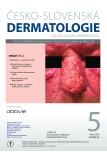Cutaneous Larva Migrans – Imported Parasitic Infection
Authors:
J. Nemšovská; D. Švecová
Authors‘ workplace:
Dermatovenerologická klinika LF UK a UNB, Bratislava prednostka prof. MUDr. Mária Šimaljaková, Ph. D., MPH, MHA
Published in:
Čes-slov Derm, 93, 2018, No. 5, p. 174-178
Category:
Pharmacologyand Therapy, Clinical Trials
Overview
Cutaneous larva migrans is one of the most frequent travel-associated parasitic skin infections imported from tropical or subtropical regions. The typical clinical presentation is caused by the migration of hookworm larvae in the epidermis. We are describing a case series of five patients (three women, two men), who were suffering from pruritic cutaneous lesions for 3 weeks, after they had returned from a trip to Thailand. The diagnosis was based on the typical clinical presentation and history of beach exposure in tropical regions. All patients were successfully treated with oral albendazol (400 mg a day for three days). In one patient, two courses of albendazol have been used.
Key words:
cutaneous larva migrans – travel-associated parasitic skin infection – hookworm – pruritus – serpiginous track
Sources
1. BELIZARIO, V., Jr., DELOS TRINOS, J. P., GARCIA, N. B. Cutaneous manifestations of selected parasitic infections in Western Pacific and Southeast Asian Regions. Curr. Infect. Dis. Rep., 2016, 18, p. 30.
2. CAUMES, E. Efficacy of Albendazole Ointment in Cutaneous Larva Migrans in 2 Young Children. Clin. Infect. Dis., 2004, 38, 11, p. 1647–1648.
3. CAUMES, E., LY, F., BRICAIRE, F. Cutaneous larva migrans with folliculitis: report of seven cases and review of the literature. Br. J. Dermatol., 2002, 146, p. 314–316.
4. CROCKER, H. R. Diseases of The Skin. 2nd ed. Philadelphia: The Blakiston Company. 1893, p. 926–927.
5. FELDMEIER, H., SCHUSTER, A. Mini review: Hookworm-related cutaneous larva migrans. Eur. J. Clin. Microbiol. Infect. Dis., 2012, 31, p. 915–918.
6. GUPTA, M. Bullous cutaneous larva migrans – a case report. J. Dermatol. Surg., 2016, 20, p. 65–66.
7. HEUKELBACH, J., FELDMEIER, H. Epidemiological and clinical characteristic of hookworm-related cutaneous larva migrans. Lancet Infect. Dis., 2008, 8, p. 302–309.
8. HOCHEDEZ, P., CAUMES, E. Hookworm-Related Cutaneous Larva Migrans. J. Travel. Med., 2007, 14, p. 326–333.
9. KAUR, S., JINDAL, N., SAHU, P. et al. Creeping Erruption on the Move: A Case Series from Northern India. Indian J. Dermatol., 2015, 60, p. 422–426.
10. KINCAID, L., KLOWAK, M., KLOWAK, S., BOGGILD A. K. Management of imported cutaneous larva migrans: A case series and mini-review. Travel Med. Infect. Dis., 2015, 13, 382–387.
11. LEE, D. L. The biology of Nematodes. CRC Press, Taylor & Francis Group: Boca Raton 2002. ISBN 9780415272117.
12. LEE, R. Case of creeping eruption. Trans. Clin. Soc. Lond., 1974, 8, p. 44–45.
13. LEUNG, A. K., BARANKIN, B., HON, K. L. Cutaneous larva migrans. Recent. Pat. Inflamm. Allergy Drug Discov., 2017, 11, p. 2–11.
14. PODDER, I., CHANDRA, S., GHARAMI, R. C. Loeffler´s syndrome following cutaneous larva migrans: An uncommon sequel. Indian J. Dermatol., 2016, 61, p. 190–192.
15. PRICKETT, K. A., FERRINGER, T. C. What´s eating you? Cutaneous larva migrans. Cutis, 2015, 95, p. 126–128.
16. SUGATHAN, P., BHAGYANATHAN, M. Cutaneous larva migrans: Presentation at an unusual site. Indian J. Dermatol., 2016, 61, p. 574–575.
17. ŠTORK, J., VORONOVOVÁ, D., VOSMÍK, J. Lineární erupce na trupu. Čes.-slov. Derm., 1998, 73, 6, p. 213–214.
18. TE BOOIJ, M., DE JONG, E., BOVENSCHEN, H. J. Löffler syndrome by extensive cutaneous larva migrans: a case resport and review of the literature. Dermatol. Online., 2010, 16, p. 2.
19. VANO-GALVAN, S., GIL-MOSQUERA, M., TRUCHUELO, M., JAÉN, P. Cutaneous larva migrans: a case report. Cases J., 2009, 2, p. 112–115.
20. VERALDI, S., PERSICO, M. C., FRANCIA, C. et. al. Follicular cutaneous larva migrans: a report of three cases and review of the literature. Int. J. Dermatol., 2013, 52, p. 327–330
Labels
Dermatology & STDs Paediatric dermatology & STDsArticle was published in
Czech-Slovak Dermatology

2018 Issue 5
Most read in this issue
- Rosacea - Current View
- Cutaneous Larva Migrans – Imported Parasitic Infection
- Periungual Garlic Clove Tumors. Minireview
- Lupus Miliaris Disseminatus Faciei. Case report
